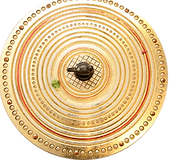
Eternal Gandhi
DISMANTLE ALL BOUNDARIES
National Gallery of Modern Art, Mumbai, 2006

Eternal Gandhi
National Gallery of Modern Art, Mumbai, 2006
Eternal Gandhi
DISMANTLE ALL BOUNDARIES

Winner
ID Magazine Design Award,
New York
2002
Eternal Gandhi

Winner
ID Magazine Design Award,
New York
2002

.png)

_edited%20(weco.png)


Creative Spirituality, Technology, Culture & Design



.png)
.png)



.png)


.png)
The World of
RANJIT MAKKUNI









Cultural Computing


Remember that these were designed in a period when the screen was text based. Gradually, my work added video representations on the screen and the Electronic Sketch Book of Thangka painting project developed
one of the world’s first ‘multimedia presentations, progressively creating ‘richer’ interactions between people and cultural content in museums, and progressively humanizing the technology.
Since these projects were usually presented in museums, they explored the transformation of the museum itself in many ways!
The documentation of traditional
cultures through digital multimedia was no passive exercise of ‘scanning-in culture!’ Instead, the laboratory’s work has shown and continues to show that engagement with cultural documentation is also a valuable process to spark off technological innovation – i.e., humanized, expressive technology allowing rich interactions..
In the late ’90s, and early 2000s, my
work began exploring the idea that
computation need not occur only on a desktop, and that it could migrate from the desktop on to people’s clothes, furniture, and cultural objects. While people have developed sophisticated hand skills to manipulate physical environments, which form the basis of traditional artistic and crafts expertise, models of computer interfaces then, and even now, did not incorporate these skills. Towards this, we explored tactile, physical interfaces, building on the paradigm shift: that the ‘world itself is the interface’.
With this vision, I established the
Sacred World Research Laboratory in Asia to show conceptual bridges between traditional techno-and traditional cultures, and to root innovation in new computing, communications media a non-western context.
The works of the laboratory, from the 2000s to the present, produced a large panorama of innovation and anticipated many of the innovations in the fields of interactive and mobile computing. Technologies were explored in the context of authoring multimedia documents based on themes of Banaras,
Gandhi, Health, Music and Goddess, and others. Each of the projects produced many first in the fields in Design and Technology and this site captures some of the rich legacy of innovation focused on humanizing computers.
I started my technology research
at Xerox Palo Alto Research Center,
just after designing one of the world’s first computer-aided sculpting and design tools at UCLA.
This was a time when the world was predominantly communicating through text representations on the screen.. This was changed by a radical invention of the graphical user interface at Xerox PARC, which developed the ability to use mouse and graphical display.
Gradually computers diminished in
size, became available on a desktop,
and provided people the ability to
‘point’ on frame buffers on screens
and organize tasks on screens in
graphical windows. Computers then
‘talked’ to each other, first through
wires, and a network of computers allowed people to share and collaborate with each other.
In this era, mid 80s, my work explored visual, kinesthetic gestures as to interact with computers, and gestural interfaces served as a way of humanizing the traditional button pushing paradigm of interactions
with computers. As early as 1985, I built a system in which one could wave a gesture on the screen and the computer would ‘understand’ what the gesture meant and translate it into parameters for the design of, say, a Chinese temple. One could make a gestural diagram and retrieve an image of a Tibetan deity matching the diagram.
Legacy of Tech Firsts
Continuous Innovation towards a humane Tech to teach us that Humanity is indeed First!
John Barlow on Cyberspace?
What is missing?
Well, to quote Ranjit Makkuni of Xerox PARC, "The prana is missing," prana being the Hindu term for both breath and spirit. I think he is right about this and that perhaps the central question of the Virtual Age is whether or not prana can somehow be made to fit through any medium but the act of Being There.
2000
First demonstrations of Design and Technology moving beyond its earlier focus on rigid, black and beige desktop workstations to the design of mobile computing, and, onwards to cultural computing, circa 1998-2001.
One of the first AR apps, e-Rickshaw.
2001
One of the world's first multimedia learning systems of any kind.

1987-1989
One of the first e-books.
1998-2001
One of the first cultural computing, document readers, mobile devices -- e-egg.
1998-2000
First ebook
First spokesperson for the cleanliness of teh Ganges
2003-4
First Gandhian timeline browser, and timeline research.
After years of disarray on Gandhian documentation, the Eternal Gandhi project integrated scattered documents into one database.
One of the first spokespersons alerting humanity to become aware of and take action about the pollution in the Ganges river.
1998-2001
World's first walk in, multimedia health dictionary. One of the first spokespersons alerting India to look within to create ubiquitous and free-for-all healthcare.
2010
Image browsing through Gestural Retrieval, 1986-7
1986-7

One of the first explorations of gesture computing, 1985-6.
Chinese Temple Design Editor


1985-6
The design and presentation of the world's first multimedia museums, 1989-2010.
1998-2010
One of the first presentations of the link between the Sacred Feminine and Music, showing the positive impact that the feminine forms could have on design.
2013
Brought the footsteps of multimedia computing to India.

1993-7
One of the first explorations showing 'rich' intersections of embedded electronics and traditional crafts.





.jpg)







